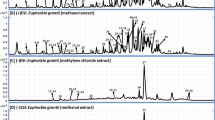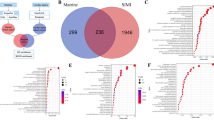ABSTRACT
In this study, we aimed to study the effects of arachidonic acid (AA) on acute lung injury (ALI) caused by paraquat (PQ) in mice. Male Kunming mice were randomly divided into three groups: control group, PQ group, and PQ + AA group (n = 24). The mice in the PQ and PQ + AA groups received a single oral dose of 20 mg/kg bodyweight PQ, and the mice of the PQ + AA group were challenged by 500 mg/kg bodyweight AA posttreatment 2 h after PQ administration. The results indicated that the administration of AA significantly increased the activity of superoxide dismutase (SOD), decreased the activity of myeloperoxidase (MPO), the content of malondialdehyde (MDA), and the level of lactate dehydrogenase (LDH). Pathological examination also revealed that AA effectively alleviated PQ-induced histological damage. Furthermore, AA significantly reduced PQ-induced upregulations of inflammatory mediators such as tumor necrosis factor (TNF)-α, interleukin (IL)-1β, IL-6, and IL-8. These results demonstrated that AA had effective protection against PQ-induced ALI.




Similar content being viewed by others
REFERENCES
Chen, J.J., T. Zeng, Y. Bi, et al. 2011. Docosahexaenoic acid (DHA) attenuated paraquat induced lung damage in mice. Inhalation Toxicology 25: 9–16.
Seok, S.J., H.W. Gil, D.S. Jeong, et al. 2009. Paraquat intoxication in subjects who attempt suicide: why they chose paraquat. Korean Journal of Internal Medicine 24: 247–251.
Zerin, T., Y.S. Kim, S.Y. Hong, et al. 2012. Protective effect of methylprednisolone on paraquat-induced A549 cell cytotoxicity via induction of efflux transporter, P-glycoprotein expression. Toxicology Letters 208: 101–107.
Tomita, M., T. Okuyama, H. Katsuyama, et al. 2007. Mouse model of paraquat-poisoned lungs and its gene expression profile. Toxicology 231: 200–209.
Awadalla, E.A. 2012. Efficacy of vitamin C against liver and kidney damage induced by paraquat toxicity. Experimental and Toxicologic Pathology 64: 431–434.
Uzun, F.G., F. Demir, S. Kalender, et al. 2010. Protective effect of catechin and quercetin on chlorpyrifos-induced lung toxicity in male rats. Food and Chemical Toxicology 48: 1714–1720.
Grosicka-Maciag, E., D. Kurpios-Piec, M. Szumilo, et al. 2011. Protective effect of N-acetyl-L-cysteine against maneb induced oxidative and apoptotic injury in Chinese hamster V79 cells. Food and Chemical Toxicology 49: 1020–1025.
Dinis-Oliveira, R.J., J.A. Duarte, A. Sánchez-Navarro, et al. 2008. Paraquat poisonings: mechanisms of lung toxicity, clinical features, and treatment. Critical Reviews in Toxicology 38: 13–71.
Valko, M., D. Leibfritz, J. Moncol, et al. 2007. Free radicals and antioxidants in normal physiological functions and human disease. International Journal of Biochemistry & Cell Biology 39: 44–84.
Riahi, B., H. Rafatpanah, M. Mahmoudi, et al. 2010. Immunotoxicity of paraquat after subacute exposure to mice. Food and Chemical Toxicology 48: 1627–1631.
Rahman, I., and W. MacNee. 2000. Regulation of redox glutathione levels and gene transcription in lung inflammation: therapeutic approaches. Free Radical Biology and Medicine 28: 1405–1420.
Kim, S., L. Dayani, P.A. Rosenberg, et al. 2010. RIP1 kinase mediates arachidonic acid-induced oxidative death of oligodendrocyte precursors. International Journal of Psychophysiology 2: 137–147.
Wang, Z.J., C.L. Liang, G.M. Li, et al. 2006. Neuroprotective effects of arachidonic acid against oxidative stress on rat hippoeampal slices. Chemico-Biological Interactions 163: 207–217.
Chen, Y., Y.C. Nie, Y.L. Luo, et al. 2013. Protective effects of naringin against paraquat-induced acute lung injury and pulmonary fibrosis in mice. Food and Chemical Toxicology 58: 133–140.
Sun, S., H. Wang, G. Zhao, et al. 2011. Complement inhibition alleviates paraquat-induced acute lung injury. American Journal of Respiratory Cell and Molecular Biology 45: 834–842.
Park, H.K., S.J. Kim, Y. Kwon do, et al. 2010. Protective effect of quercetin against paraquat-induced lung injury in rats. Life Science 87: 181–186.
Lee, J., W. Kwon, Y. Jo, et al. 2008. Protective effects of ethyl pyruvate treatment on paraquat-intoxicated rats. Human & Experimental Toxicology 27: 49–54.
Podder, B., Y.S. Kim, T. Zerin, et al. 2012. Antioxidant effect of silymarin on paraquat-induced human lung adenocarcinoma A549 cell line. Food and Chemical Toxicolog 50: 3206–3214.
Cristóvão, A.C., D.H. Choi, G. Baltazar, et al. 2009. The role of NADPH oxidase 1-derived reactive oxygen species in paraquat-mediated dopaminergic cell death. Antioxidants & Redox Signaling 11: 2105–2118.
Cui, Y., J. Robertson, S. Maharaj, et al. 2011. Oxidative stress contributes to the induction and persistence of TGF-beta1 induced pulmonary fibrosis. International Journal of Biochemistry & Cell Biology 43: 1122–1133.
Reumaux, D., M. de Boer, A.B... Meijer, et al. 2003. Expression of myeloperoxidase (MPO) by neutrophils is necessary for their activation by anti-neutrophil cytoplasm autoantibodies (ANCA) against MPO. Journal of Leukocyte Biology 73: 841–849.
Author information
Authors and Affiliations
Corresponding author
Rights and permissions
About this article
Cite this article
Du, J., Li, X., Lin, C. et al. Protective Effects of Arachidonic Acid Against Paraquat-Induced Pulmonary Injury. Inflammation 38, 1458–1463 (2015). https://doi.org/10.1007/s10753-015-0120-6
Published:
Issue Date:
DOI: https://doi.org/10.1007/s10753-015-0120-6




